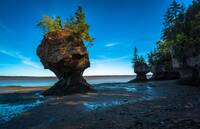
Departures: May to September 2026 & 2027
from £4,749 pp.
Book your holiday today:
Within GB: 01580 214 089 • International: +44 (0)1580 214 089
UNESCO sites are considered to be areas of "outstanding universal value to humanity" and, as such, come highly recommended when building a motorhome holiday itinerary. Here we look at The Joggins Fossil Cliffs, a UNESCO World Heritage Site nestled in Nova Scotia, Canada, which serves as a remarkable portal into earth's ancient past.
These cliffs house an unparalleled fossil record from the Carboniferous period, dating back 300 million years when verdant forests blanketed Joggins, contributing significantly to the formation of the world's coal reserves.
This extraordinary site unveils the earliest reptiles, towering trees, and colossal millipedes, all impeccably preserved within the rock strata. These fossils are not merely remnants of a bygone era; they are tangible evidence of life's evolution on earth and the dynamic processes that have shaped our planet over millennia.
Sorry, this map cannot be displayed.
The following consent is required:
Tracking & performance, Targeting & advertising.
The Joggins Fossil Cliffs' designation as a UNESCO World Heritage Site displays its global significance. This prestigious status is bestowed upon places of exceptional universal value to humanity, warranting their preservation for future generations to appreciate and enjoy. The cliffs' rich fossil record, offering a unique glimpse into the Coal Age, undoubtedly merits this recognition.
The Joggins Fossil Cliffs are more than just an intriguing geological feature; they are a living testament to earth's vibrant past and an invaluable resource for understanding the intricate tapestry of life's evolution.
The Joggins Fossil Cliffs are a result of the last Ice Age and the extreme tides of the Bay of Fundy. During the Quaternary, the most recent period of earth's history, a continental ice cap covered most of Canada, including Nova Scotia. This ice cover melted about 10,500 years ago, causing the earth's crust to rebound upward with the release of the weight. As the crust rose, the former shoreline also rose, becoming stranded high above the present-day shoreline. The ancient shore forms the flat surface at the top of the rock cliffs. Overlaying this surface is a thick layer of clay (glacial till), which washes down over the rocks and paints them brick red.
The area was a long-established coal mining region, with its coal seams exploited as early as 1686 by local Acadian settlers and by the British garrison at Annapolis Royal in 1715. The first commercial mine was set up by Major Henry Cope in 1731. Large-scale industrialisation came to Cumberland County under the General Mining Association, which held the rights to the area's coal fields.
Joggins is famous for its record of fossils from a rainforest ecosystem approximately 310 million years ago, dating to the Pennsylvanian "Coal Age" during the Late Carboniferous period. The dramatic coastal exposure of the Carboniferous rocks, known as the Joggins Fossil Cliffs, are continually hewn and freshly exposed by the actions of the tides in the Cumberland Basin.
The fossil record at Joggins figures in Charles Darwin's 'On the Origin of Species' and played a role in the Great Oxford Debate of 1860 between Bishop Wilberforce and Thomas Huxley. Much of the early work to document the fossil record at Joggins was by Nova Scotian geologist Sir William Dawson (1820–1899), who had a close personal and working relationship with his friend and mentor Charles Lyell.
In 2007, a 14.7-km length of the coast constituting the Joggins Fossil Cliffs was nominated by Canada to UNESCO as a natural World Heritage Site. It was officially inscribed on the World Heritage List on July 7, 2008. The International Union of Geological Sciences (IUGS) included the 'Coal Age Joggins Fossil Cliffs' in its assemblage of 100 'geological heritage sites' around the world in a listing published in October 2022. The organisation defines an IUGS Geological Heritage Site as a 'key place with geological elements and/or processes of international scientific relevance used as a reference, and/or with a substantial contribution to the development of geological sciences through history.'
The Bay of Fundy, situated between the Canadian provinces of New Brunswick and Nova Scotia, plays a crucial role in the existence of the Joggins Fossil Cliffs. Known for having the highest tides in the world, the Bay of Fundy experiences a tidal range of about 16 metres (52 ft), while the average tidal range worldwide is only one metre (3.3 ft). These tides are semidiurnal, meaning they have two highs and two lows each day, with about six hours and 13 minutes between each high and low tide.
The bay's powerful tides flood and withdraw every 6½ hours, relentlessly pounding the cliffs during the highest tides. This constant action undermines and sweeps away the face of the cliffs, revealing a new crop of fossils every three or four years. This continuous process of erosion and renewal allows for the ongoing discovery of new fossils, making the Joggins Fossil Cliffs a living museum of the Coal Age.

The bay is also notable for its unique hydrology. Due to tidal resonance in the funnel-shaped bay, the tides that flow through the channel are incredibly powerful. In one 12-hour tidal cycle, about 100 billion tons of water flows in and out of the bay, twice as much as the combined total flow of all the world's rivers over the same period.
The story of the Fundy Basin begins about 200 million years ago in the early Jurassic when all land on earth was part of a supercontinent called Pangaea. As continental drift reshaped the world, rift valleys, including the Cobequid–Chedabucto fault system, formed. These rifts filled with sediment, which became sedimentary rock. Many fossils have been found along the Fundy shoreline, including the oldest dinosaur fossil in Canada at Burntcoat Head and very early reptiles in Carboniferous tree trunks at Joggins.
The Bay of Fundy is a member of the Global Geoparks Network, a UNESCO initiative to promote and conserve the planet's geological heritage. Its unique intertidal habitat, the Bay of Fundy mudflats, is home to a variety of flora and fauna. Despite the lack of a formal marine protection zone in the bay, efforts are being made to protect its ecosystem, including adjusting shipping lanes to lessen the risk of collision with the critically endangered North Atlantic right whale.
The fossils found in the cliffs provide a detailed record of life during the Coal Age. The cliffs reveal the world's first reptiles, towering trees, and giant millipedes, all preserved in the rock. These fossils provide a unique insight into the biodiversity of the Coal Age. The swamp forests of the time produced massive quantities of organic matter that, over millions of years, created the coal deposits for which this period of history is named.
The detailed fossil record found in the cliffs has provided invaluable insights into the evolution of life on earth. The cliffs have helped scientists understand the biodiversity of the Coal Age and the processes that led to coal formation. The site continues to be a valuable resource for scientific research and education.
Sorry, this YouTube video cannot be displayed.
The following consent is required:
Tracking & performance, Targeting & advertising.
The Joggins Fossil Cliffs are a testament to earth's ancient history and the dynamic processes that have shaped our planet. The cliffs offer a unique opportunity to step back in time and explore the world as it was 300 million years ago. Whether you're a history buff, a nature lover, or simply someone looking for a unique travel experience, the Joggins Fossil Cliffs are a must-visit destination.
For those interested in exploring the Joggins Fossil Cliffs and the rich history they hold, consider embarking on our Canadian motorhome holiday Maritimes - Canada's Hidden Gem, which offers a unique opportunity to explore the region at your own pace, with the freedom to go where you want, when you want.




Peter Stannett
Content Writer
Peter is our content writer and SEO specialist, helping keep our content current and monitoring website traffic.
His content covers all four corners of the globe, across topics like activities, advice, food, culture and history.
More by Peter Stannett